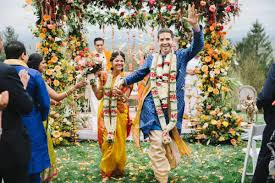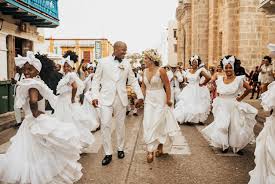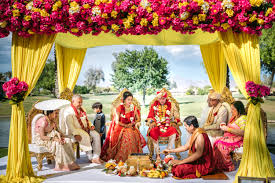Weddings are a celebration of love, commitment, and unity, but the ways in which they are celebrated vary greatly across cultures. Each culture has its own unique wedding traditions that reflect its values, history, and beliefs. In this article, we will explore some of the most unique and fascinating wedding traditions from around the world, shedding light on how different cultures honor this significant milestone in their own special ways.
1. The Colorful Wedding Rituals of India

1.1 The Mehendi Ceremony
In India, weddings are grand and elaborate affairs that often span several days. One of the most vibrant traditions is the Mehendi ceremony. During this pre-wedding ritual, the bride’s hands and feet are adorned with intricate henna designs. These designs are not just beautiful but also hold cultural significance, symbolizing fertility, luck, and the bride’s journey into her new life.
1.2 The Baraat Procession
Another unique aspect of Indian weddings is the Baraat, where the groom arrives at the wedding venue on a decorated horse or in a grand procession. Accompanied by family and friends, the groom dances and celebrates on his way to the bride’s home. This tradition highlights the festive and joyous nature of Indian weddings and the importance of family and community in the celebration.
2. Japanese Weddings: The Serenity of Shinto Ceremonies
2.1 The Shinto Wedding Ceremony
Japanese weddings are deeply rooted in Shinto traditions, which emphasize purity, simplicity, and respect for nature. A traditional Shinto wedding ceremony involves the couple paying homage at a Shinto shrine, where they perform rituals such as exchanging nuptial cups of sake and reciting vows in the presence of the Kami (deities). The ceremony reflects the harmony and spirituality cherished in Japanese culture.
2.2 The White Kimono
The bride traditionally wears a white kimono called a “shiro-muku” for the ceremony, symbolizing purity and a fresh start. After the ceremony, she may change into a colorful kimono to represent the joyful transition to married life. This practice highlights the elegance and cultural heritage of Japanese wedding attire.
3. The Joyous Celebrations of Mexican Weddings

3.1 The Lazo Ceremony
Mexican weddings are known for their vibrant celebrations and cultural richness. One notable tradition is the Lazo ceremony, where the bride and groom are draped with a large, ornate rosary or lasso in the shape of a figure-eight. This symbolically binds them together and represents their commitment to each other and their faith.
3.2 The Dollar Dance
Another fun tradition in Mexican weddings is the Dollar Dance, also known as the “Baile del Dinero.” During this dance, guests pin money to the bride and groom’s attire while they dance. This custom is a way for guests to contribute financially to the newlyweds’ future and celebrate their union with joy and generosity.
4. Scottish Weddings: Embracing Tradition with Tartan and Bagpipes
4.1 The Wearing of Tartan
Scottish weddings are steeped in tradition, with the groom often donning a kilt made of tartan fabric, which represents his clan or family heritage. The kilt is a significant symbol of Scottish identity and pride. The bride may also incorporate tartan into her attire or use traditional Scottish elements in her wedding dress.
4.2 The Piping of the Bride
Bagpipes play a crucial role in Scottish weddings, adding a distinctive and celebratory sound to the occasion. The “piping of the bride” is a tradition where the bride is escorted down the aisle by a piper, creating a dramatic and memorable entrance. This tradition highlights the cultural importance of music and ceremonial customs in Scottish weddings.
5. Traditional Chinese Weddings: The Art of Red and Symbolism
5.1 The Red Wedding Dress
In Chinese weddings, the color red is considered auspicious and symbolizes good fortune and happiness. The bride traditionally wears a red wedding dress adorned with gold embroidery, which is believed to ward off evil spirits and bring prosperity to the couple. The vibrant red attire contrasts with the more subdued colors typically seen in Western weddings.
5.2 The Tea Ceremony
The Chinese tea ceremony is a significant and meaningful tradition where the bride and groom serve tea to their elders as a sign of respect and gratitude. This ritual reinforces family bonds and demonstrates the couple’s commitment to honoring their family’s heritage and values.
6. African Wedding Traditions: A Celebration of Community and Culture
6.1 The Jumping the Broom Ceremony
In many African American and West African cultures, the “jumping the broom” ceremony is a symbolic tradition that represents the couple’s transition into married life. The couple jumps over a broom together to signify their commitment to building a new home and family. This tradition is a powerful symbol of unity and the blending of cultural heritage with modern practices.
6.2 The Kente Cloth
In Ghanaian weddings, the Kente cloth is an important and symbolic element of the ceremony. The bride and groom often wear brightly colored Kente cloth, which is handwoven and represents different meanings depending on its patterns and colors. The use of Kente cloth in weddings reflects the cultural significance and artistry of traditional Ghanaian textiles.
7. Hindu Weddings: The Sacred Rituals and Symbolism

7.1 The Saptapadi Ceremony
Hindu weddings are rich with sacred rituals and symbolism. One of the most important ceremonies is the Saptapadi, or “Seven Steps.” During this ritual, the bride and groom take seven steps around a sacred fire while reciting vows and promises. Each step represents a specific vow, and the ceremony signifies their commitment to each other in various aspects of life.
7.2 The Mangalsutra
The Mangalsutra is a significant piece of jewelry worn by the bride during a Hindu wedding. It is a sacred necklace that symbolizes the husband’s protection and the wife’s commitment to him. The Mangalsutra is an important tradition that reflects the spiritual and cultural aspects of Hindu marriage.
Conclusion
Weddings are a universal celebration of love and commitment, but the ways in which they are celebrated can vary greatly across cultures. From the vibrant Mehendi ceremonies in India to the serene Shinto weddings in Japan, each culture brings its unique traditions and symbolism to the wedding celebration. These diverse practices not only enrich our understanding of different cultures but also highlight the universal values of love, unity, and respect that transcend borders. As we continue to embrace and appreciate these unique wedding traditions, we gain a deeper appreciation for the rich tapestry of human experience and cultural heritage.

